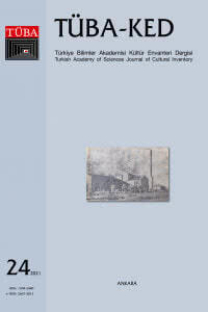19.YÜZYILA AİT EL YAZMA BİR DUA KİTABI BAĞLAMINDA BÜYÜ-DİN İLİŞKİSİ*
MAGIC-RELIGION RELATIONSHIP IN THE CONTEXT OF A 19TH CENTURY RELIGIOUS MANUSCRIPT
___
- AKTAY, Yasin, 2000. Türk Dininin Sosyolojik İmkânı, İletişim Yayınları,
- ALKAN, Mustafa, 2012. Milli Kütüphane 2727 Numaralı Mecmûada Kayıtlı Manzum Bir Melheme, Turkish Studies, Volume 7/4, Fall, s. 689-709.
- AL-KHAMIS, Ulrike, 1990. The Iconography of Early Islamic Lusterware from Mesopotamia: New Considerations Muqarnas, Vol. 7, BRILL, pp. 109-118. http://www.jstor.org/ stable/1523124 18/04/2011
- AMES, Michael M., 2009. Buddha and the Dancing Goblins: A Theory of Magic and Religion, American Anthropologist, Volume 66, Issue 1, 1990.
- ARBERRY, A. J., (1966) 2000. Introduction, Muslim Saints and Mystics, Farid al-Din Attar, Omphaloskepsis, Ames.
- ARSLAN, Mustafa, 2004. Türk Popüler Dindarlığı, Dem Yayınları, İstanbul.
- BEATTIE, John, 1996. Ritual and Social Change, Man, New Series, Vol. 1, No. 1, Royal Anthropological Institute of Great Britain and Ireland, pp. 60-74. http://www.jstor.org/stable/2795901 15/04/2015.
- BLAIR, Sheila S., 2001. An Amulet from Afsharid Iran The Journal of the Walters Art Museum, Vol. 59, Focus on the Collections, The Walters Art Museum, pp.85-102. http://www.jstor. org/stable/20168605 20/04/2011
- CAMMANN, Schuyler, 1969. Islamic and Indian Magic Squares I, History of Religions, Vol. 8, No. 3, The University of Chicago Press, Chicago, pp. 181-209. http://www.jstor.org/ stable/1061759, 11/04/2011.
- CASSIRER, Ernst, 2005. Sembolik Formlar Felsefesi II. Mitik Düşünme, Çev. Milay Köktürk, Hece Yayınları, Ankara.
- CEYHAN, Semih, 2010. Şemsül-Maârif, Türkiye Diyanet Vakfı İslâm Ansiklopedisi, 16. Cilt, TDV, Ankara, 2010, s. 531- 533.
- DAVIS, K., 1948 Human Society, Macmillan, New York.
- DIETRICH, A., 2004. Al Bûni, The Encyclopaedia of Islam, Bosworth, C. E., Van Donzel, E., Heinrichs, W. P., Lecomte, G. (Eds.), Volume XII, Brill, Leiden, pp. 156-157.
- EL-BÛNİ, Ahmed bn. Ali, 1979. Şemsül-Maarif, Çev. Selahattin Alpay, Sedef Yayınevi, İstanbul.
- EL-HÜSEYNİ, Süleyman, 1990. Havas-ul Kuran Kenz-ül Havas, Sadeleştiren Mustafa Varlı, Esma Yayınları, İstanbul.
- ÉLIADE, Mircea, 1994. Ebedi Dönüş Mitosu, Çev. Ümit Altuğ, İmge Kitabevi, Ankara.
- FAHD, Toufic, Sihr, 1997. The Encyclopaedia of Islam, Bosworth, C. E., Van Donzel, E., Heinrichs, W. P., Lecomte, G. (eds.), Volume IX, Brill, Leiden, pp. 567-571.
- GAFFNEY, Patrick D., 1992. Popular Islam, Annals of the American Academy of Political and Social Science, Vol. 524, pp. 38-51.
- GARDET, L., 1991. Dua, The Encyclopedia of Islam, B. Lewis, Ch. Pellat, J. Schacht (Eds.), E.J. Brill, Volume II, Leiden, 4th impression, pp. 617-618.
- GIRARD, René, 2005. Günah Keçisi, Çev. Işık Ergüden, Kanat Yayın, İstanbul.
- GOODY, Jack, 1961. Religion and Ritual: The Definitional Problem. British Journal of Sociology, 12, pp. 142-164.
- GÜR, Nagihan, 2012. Osmanlı Fal Geleneği Bağlamında Yıldıznâme, Falnâme ve Tâlinâme Metinleri, Millî Folklor, Yıl 24, Sayı 96, s. 202-215.
- HSU, L., K., 1952. Religion, Science and Human Crise, Routledge and Kegan Paul, London.
- KRUK, Remke, 2005. Harry Potter in the Gulf: Contemporary Islam and the Occult, British Journal of Middle Eastern Studies, Vol. 32, No. 1, Taylor & Francis, pp. 47- 73.
- LÉVI-STRAUSS, Claude, 1993. Din ve Büyü, Çev. ve Der. Ahmet Güngören, Yol Yayınları, İstanbul.
- LONG, Charles H., 1987. Popular Religion, The Encyclopedia of Religion, Volume 11, Editor: Mircea Eliade, Macmillan Publishing Company, N.Y.
- MALINOWSKI, Bronislaw, 1948. Magic, Science and Religion and Other Essays, Beacon Press, Boston, Massachusetts.
- MANDELBAUM, David G., 1966. Transcendental and Pragmatic Aspects of Religion, American Anthropologist, New Series, Vol. 68, No. 5, pp. 1174-1191. URL: http://www.jstor.org/ stable/671039 11/04/2015
- OBEYESEKERE, Gananath, 1963. The Great Tradition and the Little in the Perspective of Sinhalese Buddhism, The Journal of Asian Studies, Vol. 22, No. 2, pp. 139-153.
- REDFIELD, Robert, 1956. Peasant Society and Culture an Anthropological Approach to Civilization, The University of Chicago Press, Chicago.
- ROXBURGH, David J.(Ed.), 2005. Turks: A Journey of a Thousand Years 600-1600, Royal Academy of Arts, London.
- RUSKA, J., Vefk, 1986. Vefk, İslam Ansiklopedisi, Cilt XIII, Milli Eğitim Basımevi, İstanbul, s. 256-258. SESIANO, J., 2002. Wafk, The Encyclopedia of Islam, Volume XI, Brill, Leiden, s. 28-31.
- STARK, Rodney, 2001. Reconceptualizing Religion, Magic, and Science, Review of Religious Research, Vol. 43, No. 2, Religious Research Association, pp. 101-120. http://www.jstor.org/ stable/3512057 07/04/2015.
- ŞANLI, İsmet, 2003. XXV. Yüzyıl Divan Şâiri Fedâyî ve Fâl-Nâme-i Kurân-ı Azîmi, U.Ü. Fen-Edebiyat Fakültesi Sosyal Bilimler Dergisi, Yıl 4, Sayı 5, s. 161-178.
- TITIEV, Mischa, 1960. A Fresh Approach to the Problem of Magic and Religion, Southwestern Journal of Anthropology, Vol. 16, No. 3, University of New Mexico, pp. 292-298. http://www.jstor.org/stable/3629032 17/04/2015
- ISSN: 1304-2440
- Yayın Aralığı: 2
- Başlangıç: 2003
- Yayıncı: Türkiye Bilimler Akademisi
19.YÜZYILA AİT EL YAZMA BİR DUA KİTABI BAĞLAMINDA BÜYÜ-DİN İLİŞKİSİ*
GEÇMİŞTEKİ SU KÜLTÜRÜNÜN SEMBOLLERİ: İZMİRÇEŞME'DE MEVCUT VE KAYIP OSMANLI DÖNEMİ ÇEŞMELERİ
Ahmet KARAÇÖL, Selim Sarp TUNÇOKU
KÜLTÜREL MİRAS KORUMA YAKLAŞIMLARININ TARİHSEL GELİŞİMİ
ORDU / PERŞEMBE'DEN İKİ AHŞAP ÇANTI CAMİ ÖRNEĞİ
TARİHE TANIKLIK EDEN EVLERDEN BİR ÖRNEK: SALİHLİ MÜDİRE HANIM EVİ
KENT MEKANINDA MİKRO ÖZGÜRLÜK ALANLARI*
